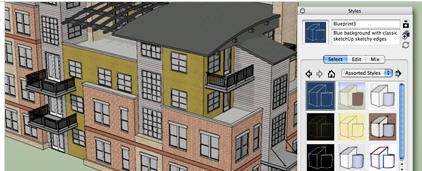I just received the latest ZweigWhite Information Technology Survey for 2008. It provides a wealth of information to see where the industry is going and how you may stack up. It is an annual survey of A/E firms. This year 129 firms participated. Data was collected during Jan, Feb and March of 2008.
I eagerly look through this document for interesting information about all sorts of topics. They have 10 areas of survey results that range from firm information, to CAD and BIM, to Project Web sites, to communication tools and so much more.
I have tracked the last few publications and found that the level of CAD Standards development has increased over the years.
In 2006 91% of the firms responded that they had a written CAD Standard. In 2007 it went up to 92%. Now in 2008 it is 94%. Of this percentage 67% say that the standard covers all offices. 15% have differing standards for differing locations and 12% use a client or specific project standard.
It is encouraging to think that almost everyone now has a written standard. How good they are may be another question. How often they are reviewed and enforced may be another.
Does your firm have a written standard?
Well – nothing like waiting until the last minute…
The last day to submit proposals for Autodesk University 2008 (Las Vegas, Dec. 2008) was Sunday the 27th. So I just got in under the wire. You can actually help define the classes that will be presented at AU 2008. This is something new. You can vote on your options…

I submitted the following:
CAD Leadership – 2008 – Some offices seem to hum with productivity; others struggle with differing opinions and methods. And some never seem to advance in the use of their software tools. What makes the difference? Often the answer is CAD leadership and the CAD Manager. Who you are will make a deeper impact on your firm and the office CAD productivity output. Come and find out key concepts you can use to create the environment for positive technology use. Practical – real world advice on taking the next step in your career.
CAD Manager Career Path – Some people stumble into CAD Management. Others strive to get there but never seem to make it. There may actually be a well defined path to travel. We will discuss what you need to get the job, how to hold on to the job and how to advance your career to the next level. No matter where you are on the ladder of success, you will come away with practical time tested ways to move up.
Preventative CAD Management – Preventative (or Proactive) CAD Management involves the concept of setting up processes and guidelines in order to prevent things from going wrong. Reactive management just responds to problems as they come up. This is part of the job, but can often settle you into the rut of responsiveness. Responding to, but not avoiding problems. Just like changing the oil in your car is a preventative measure, there are some things you can put into place to avoid having troubles later on.
and a couple of new ones…
Common Sense CAD – Most people never really think about what they are doing in CAD.They never know the unwritten rules. They just keep doing the things that they were taught and don’t think about the reasons they do them. We will discuss the undiscussed rules of CAD. Those areas that get violated every day by someone. Are you using your common sense when you use CAD?
BIM Manager – The Newest Position – BIM Manager, BIM Leader, BIM Coach, BIM Coordinator. Just some of the titles being handed out to those forward thinking BIM leaders. There is a new position that is developing as BIM progresses. It is one dedicated to overseeing BIM projects. Is it different that CAD Manager? Is it the same? What duties should a BIM Manager be doing? What are the same? Is this a short term evolution or is the CAD Manager being replaced? Discover what it takes to be a BIM Manager.
I am not sure which ones – if any – will be selected.
Check out more on AU 2008 here
Are you planning on attending?
Autodesk helps you – help yourself…
From the site:
What is Autodesk® Seek?
It is a web service that allows designers – architects, engineers, students – to search and find generic or manufacturer-specific building products or components and associated design content. This content could include 3D models, 2D drawings, specifications, and descriptions for that product or component.
Which industries are you targeting with Autodesk® Seek?
Currently, it is targeted at designers working in the AEC (Architecture, Engineering, and Construction) industry. We are considering extending the service to include content particularly useful for mechanical designers in the future.
What are the system requirements for Autodesk® Seek?
This is a web service, so all you need is an internet connection and a web browser. The browsers that are recommended are Firefox 2.0 and Internet Explorer 7.
How do I download files from Autodesk® Seek to use with my design applications?
After either searching or browsing for the file that you are looking for, select the row in the search results page that you are interested in. This will allow you view additional details about the product or component that you are interested in as well as allow you to download the relevant design files. The first time you download a file, you will be required to confirm that you have and agree to the Terms of Use. Download the file to the desired location and use the appropriate design application to open the file.
What types of files are available from Autodesk® Seek?
We have adopted an open approach in order to provide you with the design file or product specification that you need regardless of its format. This service is not restricted to only providing you files that are of an Autodesk format. You will find everything from Revit product family files and DWG files to DGN and SKP files to Microsoft Word documents and PDFs.
Go to Autodesk Seek
What others are saying…
The focus this month will be on keeping your current position or landing that new job. Some of you may be looking for greener pastures or unfortunately out of a position. Some may be trying to move into the CAD Manager roll. So here are some words of advice.
Interviewing for a CAD Manager Job
Book Review – AutoCAD 2009 Fundamentals – by Ascent
If you want to sign up for the journals email delivery click here

We encountered a little problem that had us concerned until we figured out what was going on.
We had been running low on our seat count for licenses of SketchUp. We use a network license scheme that allows multiple people to share licenses as needed. Over the last few days we were running low on licenses and some were getting locked out. When we checked on it, several people were running multiple copies at one time.
We found that if you double click on a SketchUp file it open a new instance of SketchUp and takes up one license. Double click on another SketchUp file and another license gets checked out. We had several doing this and running multiple copies of SketchUp on the same machine. They had no idea they were doing it, but it was right there in their system tray. 3-4-5 seats of SketchUp running on the same machine.
Once we figured this out, we were okay again.
Sometimes it is the simplest things that catch you short handed.
I have just completed a series of Revit meetings. They were focused on teaming up on projects and defining Revit standards. The project is large and three architectural firms are working on it. We are developing a template building, then use it to create three different facilities at three different locations.
Some of the questions that we worked through related to how to split the model to share between the three teams? Do we split it vertically or should we use some other logic (division of work, ease of use, legibility, file size)? We found that sharing certain modeled components and views between three models can be difficult – possibly a Revit limitation. We found that we would take the model to a point where the model – shell and core – is sharable. What is more difficult to share later should be in the model sooner. Families would be developed by dividing the work between the teams and then sharing between us all.
I am finding that the same issues are effecting other teams now in Revit. It use to be that BIM pioneers where out there on their own. The new frontier seems to now be teaming. And this seems to be coming from the clients. They are asking firms to team up. I am not speaking of teaming with consultants from other disciplines, I mean other firms doing the same thing that you are. It may be because the project is large or consists of multiple buildings, but you may soon be teaming up…
Have you been asked to team up with other firms on large projects? Other firms that do the same design work as you? Architects with Architects, Structural with Structural…
I have a lot of people hitting my site for info on Revit with Mental Ray Rendering.
This is available in Revit Architecture 2009, Revit Structure 2009 and Revit MEP 2009
Here are a few links that might provide more info…
Mental Ray comparison to Accurender in Revit Architecture 2009
Revit 2009- two words- Mental Ray!
32-bit AutoCAD 2009
Running under Windows XP:
- Microsoft Windows XP SP2 operating system
- Intel® Pentium® 4.3 processor or AMD Athlon®, 3.0 GHz or greater – Dual core supported
- 2 GB RAM – 3GB Recommended
- 2.5 GB free hard disk space for installation
- 1024×768 VGA with true color
- Microsoft Internet Explorer 6.0 (SP1 or higher)
- DVD Drive
—-
64-bit AutoCAD 2009
(The 64-bit software cannot be installed on a 32-bit operating system)
- Windows XP Professional x64 Edition operating system
or
Windows Vista 64-bit operating system - AMD Athlon 64 processor
or
Intel EM64T processor - 2 GB RAM – 4 GB Recommended
- 3.5 GB free hard disk space for installation
- DVD Drive
System Requirements
- Windows® XP Home, Professional and TabletPC (SP1 or SP2), Windows XP Professional x64 Edition,Windows Vista® 32 bit (Business, Premium and Ultimate), Windows Vista 64 bit (Business, Premium and Ultimate)
- Microsoft® Internet Explorer® 6.0 SP1 or later
- Intel® Pentium® 4 1.4 GHz or equivalent AMD Athlon® processor
- 1 GB RAM
- 1280 x 1024 monitor and display adapter capable of 24-bit color
- 3 GB free disk space
- MS-Mouse compliant
- Download and Installation from DVD
System Recommended:
- Windows XP Professional SP2 or later, Windows XP Professional x64 Edition
- Microsoft® Internet Explorer® 6.0 SP1 or later
- Intel™ Core® 2 Duo 2.40GHz or equivalent AMD Athlon® processor
- 4 GB RAM
- 1280 x 1024 monitor and display adapter capable of 24-bit color.
- Dedicated video card with hardware support for OpenGL spec 1.3 or later
- 5 GB free disk space
- MS-Mouse compliant

